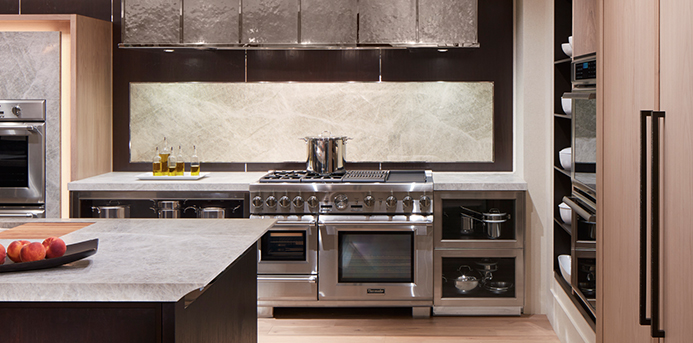Everyone knows home is where the heart is, and in today’s frantic, modern world, the kitchen has become not only the nerve center of the home, but often the one place where families still find the time to come together. The benefits of meeting at the table for a nightly family dinner are numerous — and we have some great ways to help you and your family make it a priority.
If your kitchen is in need of a bit of a facelift to help keep it the place where you and your family love to spend time, we’ve got good news and we’ve got bad news. The good: You won’t have to replace your stove — or fridge or dishwasher — often. The bad: When the time comes, there will be lots of decisions to make. You’ll want to select the optimal appliances that not only suit your family’s lifestyle, but will maximize your home’s resale potential. And you’ll want to make choices that are environmentally responsible, too. To ensure you choose the kitchen appliances that best suit your needs, we asked the experts to break down all the options.
Cooktops
The battle of gas versus electric has raged for decades, but a relatively new competitor — induction — has recently joined the fight. Chicagoland remains predominantly a gas market, as many homes in the area already have gas lines. Homeowners appreciate the ease of controlling heat without relying on the pre-set temperature markers of electric stoves, and when it comes right down it, “gas is just a more familiar way of cooking here — people like being able to see and control how high the flame is,” says Rafal Stachurski of Abt. Enter induction, which doesn’t have a flame but does boast a few advantages: the surface cools faster, there’s a lower burn risk, and “nothing beats it in terms of speed and efficiency,” says Zachary Gasiorowski of Sub-Zero Group Midwest.

Ventilation
A quality ventilation system is something that few customers prioritize when putting together a new kitchen — and that could be a big mistake, as it’s the only way to eliminate heat, odor, grease, smoke and steam. “It isn’t a sexy appliance, but it’s super important — and in a perfect world, you should begin designing your kitchen with a ventilation system in mind,” Gasiorowski says.
Microwave hoods tend to be used for ventilation in small kitchens, says Dina Michaels of Novak and Parker, but they’re not your only option. Depending on your cooking surface, Gasiorowski recommends exploring chimney-style hoods, which come in many sizes, shapes and styles, and tend to be much more effective.
Refrigerators
It can be said that there’s a refrigerator for every appetite: Side by side, top and bottom — the options are endless. Personal preference will dictate which style is best for you, but a model with French doors above a freezer drawer is generally considered to be the most functional.
“Most households open the refrigerator many times throughout the day, whereas the freezer is used less frequently,” Michaels says. “The convenience of having the refrigerated items at eye level has kept the market trending toward bottom-level freezers.”
Side-by-side units, meanwhile, may be best for a customer who doesn’t want to stack frozen items atop one another in a drawer, Michaels says. And since top-freezer units are the most price effective, and they tend to be used most often in multi-unit buildings or as replacement models.
Microwaves
Whether you’re a zapper or a nuker, chances are you’re one of the many Americans who can’t live without a microwave. And for people who like to reheat in a way that’s familiar, a microwave is a kitchen must-have. But what if we told you there was a better option? Whelp, there is: the steam oven. Just like a microwave, steam ovens are available in both countertop and wall-mounted options, and they’re ideal for reheating leftovers without drying out your food, or cooking smaller portions of anything that could go in the regular oven, Stachurski says. The difference? They heat food slower than a microwave and faster than an oven — but with steam, which keeps food moist. Even better, an investment in a steam oven can add value to your kitchen, Michaels says.
“It’s an incredibly efficient, healthy way to cook,” she says. “Once a consumer sees the plethora of features and benefits a steam oven offers, it’s almost always something that gets added.”
All that said, this isn’t necessarily an either/or situation. If a kitchen can accommodate both a microwave and a steam oven, both can be included.
Water and Ice
Some people love drinking a cold glass of purified water with perfectly clear, cubed ice, while others don’t mind a cup of tepid water from the sink. Either way, making a water source you’re eager to utilize a priority in your kitchen is important, not just because of the countless benefits to staying hydrated, but because having a desirable water source in your kitchen will make you far less likely to reach for bottled water, which wreaks havoc on the environment. It’s a matter of personal preference, whether you choose to order a refrigerator with a built-in water filtration and ice dispensation system, go for a separate water and ice dispenser, or opt for none at all, Gasiorowski says. When weighing your options, consider where you tend to drink water. If you spend a lot of time outdoors or on your deck or porch, a separate dispenser might be best. And when it comes to ice, in-fridge ice makers tend to be good enough for the average water-drinker, but die-hard ice fans (or at-home mixologists) may prefer a counter-height, dedicated ice maker, which makes clear, top-hat shaped cubes, and holds a large amount at once. “Its only purpose in life is to make ice, so it does it well,” says Gasiorowski.
Dishwashers
Close your eyes and picture a dishwasher, and an image of the full-size, pull-down door likely comes to mind. That said, there’s another option: dishwasher drawers. As the name implies, they pull out from the cabinetry like a drawer, and hold fewer dishes than a traditional door-style model. “These units tend to work best for empty nesters, who like to do a small load on a daily basis, or in a bar area, where glasses and appetizer plates can be washed without hassle,” Michaels says.
Believe it or not, regular dishwasher use is actually better for the environment than hand-washing your dishes. To maximize the green effect, be sure to choose a high-efficiency, Energy Star-certified dishwasher.
More from Make It Better:
- 5 Things That Could Derail Your Home Closing
- 6 Trends That Turn Your Home Gym Into a ‘Luxercise’ Room
- Before and After: See How Rebuilding Together Transforms Homes and Lives

Megan Craig has been a journalist for more than a decade, writing and editing stories on a variety of subjects. Most recently, her writing has focused on real estate trends in the Midwest and around the country. She lives in Chicago’s Printers Row neighborhood with her roommate and a few too many cats.

